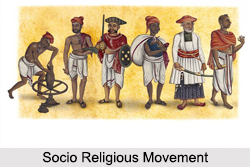 The word `Suddhi` is a Sanskrit word and it means cleansing, purity, freedom from defilement and purification. The word was used for an ancient Brahminical ritual which aimed at recreating the state of purity after polluting contact or impure activity. In the nineteenth century, the term was used to reintegrate Brahmins, who had crossed the kalapari or travelled out of their respective biradris (communities). The concept of suddhi played a major role. In 1886 a few Arya Samaj leaders recognised the unifying potential of Suddhi. An exact set of rites was elaborated and the new ceremony was declared to be authoritative. Thus, the Suddhi Movement came into being and tried to save the reconverted from possible restrictions by their caste clans.
The word `Suddhi` is a Sanskrit word and it means cleansing, purity, freedom from defilement and purification. The word was used for an ancient Brahminical ritual which aimed at recreating the state of purity after polluting contact or impure activity. In the nineteenth century, the term was used to reintegrate Brahmins, who had crossed the kalapari or travelled out of their respective biradris (communities). The concept of suddhi played a major role. In 1886 a few Arya Samaj leaders recognised the unifying potential of Suddhi. An exact set of rites was elaborated and the new ceremony was declared to be authoritative. Thus, the Suddhi Movement came into being and tried to save the reconverted from possible restrictions by their caste clans.
During the nineteenth century or in the 1860s, acute problem had arisen in the country when the Protestant missionaries had a growing success with conversion campaigns among the `untouchables`. This conversion led paranoia among the mass of an `extinction of the Hindu race`. Thus in the view of the Arya Samajis, one of the greatest deficiencies of Hinduism and a major reason for its decline since the golden age of the Vedas was the want of a ritual of conversion. According to the sect active proselytization would help the Hindus resistant against the propaganda of Christian and Islamic missionaries. Thus the Arya Samajis urged the Hindus that they should awake from their slumbers; otherwise all the Hindus would get converted to Christianity will take place and Christianity will take as strong a hold in the Punjab as Buddhism once did.
The Arya Samajis were threatened with the invention of a mode of conversion and wanted to present themselves as the protectors of the entire Hindu community. In this regard the Suddhi Movement started. However, the split of the Punjab Arya Samaj in 1893 over the questions of vegetarianism and the curricula for the educational institutions by the Samaj did not affect the pursuit of suddhi activity. The year 1896 witnessed a huge purification movement. The concept was widened in the sense that suddhi was no longer used merely to reclaim `apostates`; it was also employed as a means of integrating the untouchables into the varna system. In the first decade of the movement, most of the reclaimed had been Christians. Thereafter, the focus shifted to neo-Muslims. The members of the Arya Samaj felt the need to come forward and accomplish the task of defending Hinduism.



















